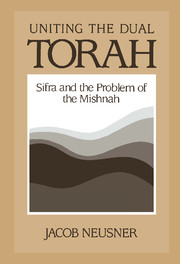Book contents
- Frontmatter
- Contents
- Preface
- Prologue
- 1 The Problem of the Mishnah
- 2 Torah as a Common Noun: The Solution of the Talmuds
- 3 A Sample of Sifra
- 4 From Common Noun to Proper Noun: Sifra's Re-presentation of the Two Torahs as One
- 5 Sifra's Alternative to the Mishnah's Topical Program and Its Order
- 6 Sifra's Alternative to the Mishnah's Logic of Cogent Discourse
- 7 Sifra's Alternative to the Mishnah's Proof of Propositions through Taxonomic Classification and Hierarchization
- 8 Re-presenting the Torah: Sifra's Rehabilitation of Taxonomic Logic
- 9 Torah as Proper Noun and the Structure of the Logic of Creation
- Appendix: The Distinctive Character of Sifra among Midrash Compilations
- Bibliography
- Index
2 - Torah as a Common Noun: The Solution of the Talmuds
Published online by Cambridge University Press: 06 July 2010
- Frontmatter
- Contents
- Preface
- Prologue
- 1 The Problem of the Mishnah
- 2 Torah as a Common Noun: The Solution of the Talmuds
- 3 A Sample of Sifra
- 4 From Common Noun to Proper Noun: Sifra's Re-presentation of the Two Torahs as One
- 5 Sifra's Alternative to the Mishnah's Topical Program and Its Order
- 6 Sifra's Alternative to the Mishnah's Logic of Cogent Discourse
- 7 Sifra's Alternative to the Mishnah's Proof of Propositions through Taxonomic Classification and Hierarchization
- 8 Re-presenting the Torah: Sifra's Rehabilitation of Taxonomic Logic
- 9 Torah as Proper Noun and the Structure of the Logic of Creation
- Appendix: The Distinctive Character of Sifra among Midrash Compilations
- Bibliography
- Index
Summary
Building on the Structure of the Mishnah: The Solution of the Talmuds
The character and uses of the Mishnah made necessary the formation of the Talmuds, its constant exegetical companions. For with the processes of exegesis and application of the Mishnah came the labor of collecting and arranging these exegeses, in correlation with the Mishnah, read line by line and paragraph by paragraph. The result was the formation of adhoc and episodic amplifications and clarifications, which ultimately comprised the first stratum of the two Talmuds. The process, once applied to the Mishnah, overspread the limits of that document. Within the work of exegesis of Scripture was the correlative labor of organizing what had been said verse by verse, following the structure of a book of the Hebrew Bible. The sorts of things the sages who framed the Talmuds did to the Mishnah, they then went and did to Scripture. Just as the Mishnah was subjected to an exegesis consisting of citation and gloss, so Scripture was addressed in the same way by sages of the same circles. But the Mishnah framed the focus of initial interest and its requirements then dictated what would be done with Scripture. The documents all focus attention on the Mishnah in particular. Three of them, the Tosefta and the two Talmuds, the Talmud of the Land of Israel, a.k.a. the Yerushalmi, ca. A.D. 400, and the Talmud of Babylonia, a.k.a. the Bavli, ca. A.D. 600, organize everything at hand around the redactional structure supplied by the Mishnah itself.
- Type
- Chapter
- Information
- Uniting the Dual TorahSifra and the Problem of the Mishnah, pp. 31 - 46Publisher: Cambridge University PressPrint publication year: 1990



